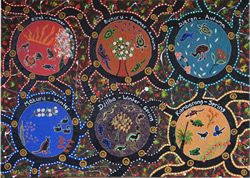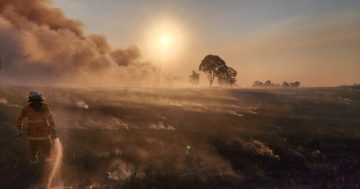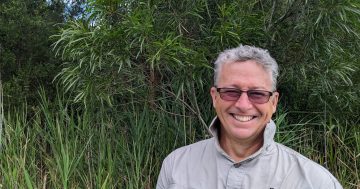Katherine Wilson* says the concept of four seasons doesn’t work for Australia – but Indigenous knowledge could help us understand and respond to our climate.
 Any Australian who believes in four seasons is engaged in a form of climate denial.
Any Australian who believes in four seasons is engaged in a form of climate denial.
It’s not an evidence-based belief.
Spring, summer, autumn and winter are colonial constructs, not an objective truth.
I recently visited Thornbury Primary School in Melbourne’s inner north, which has the largest Indigenous student population in Melbourne.
There, the kids made a mural depicting the eight seasons of greater Melbourne.
Eight.
Not six, as it was once thought, before a confluence of knowledges came to light.
Many elders at the Wurundjeri Tribe Council now recognise the truth of this.
I recognised it, too, not because I’m from the Kulin nations (traditional custodians of the Port Phillip region), but because I’m from a family of farmers and horticulturists.
Those who propagate seeds and cultivars in Australia’s temperate zones are aware that certain varieties only germinate in narrow temporal intervals, such as “early spring” or “mid-autumn”.
Not merely “spring” or “autumn”, because these taxonomies are absurdly broad.
Few Australian locations have four seasons in the Northern Hemisphere sense.
Western Australia’s Nyoongar Country has six – each representing the cycle of life.
Yirrganydji traditional lands have five, and parts of Arnhem Land have three – each attuned to wetness, wind and humidity.
Gariwerd Country, around Victoria’s Grampians, has six seasons: right now, it’s Petyan, the season of tempestuous weather when the Emu constellation appears.
Each seasonal schema is specific to discrete cycles within regional landscapes and their attendant weather systems.
To impose a one-size-fits-all classification on to this continent disregards millennia of First Nations knowledges.
In southern states, gardeners and farmers observe the eight seasons by cleaving the colonists’ seasons into intra-seasonal segments.
We determine these not according to numbers on a calendar but by observable conditions of humidity, dewpoints, sunlight angles, radiant heat, wind patterns, warmth and wetness of topsoil, bandwidth of temperatures, woodiness and hormonal stages of new shoots, activities of bees, water levels of creeks, migration of animals.
All these patterns change dramatically in the course of weeks – they can’t be neatly generalised into quarterly calendar instalments.
It’s by a constellation of conditions that many farmers understand that harvest seasons, or times to plant for optimal yields, are imminent.
If we want to understand our climate emergency’s impacts on Australian landscapes, and the integrated ways we can respond and measure reparation, these First Nations seasonal schemas inform us in ways settler models can’t.
In my locality, they advise me when to harvest and when to plant.
This is especially important for the nascent revival of sustainable and rapidly commercialising bush foods such as the yam daisy, warrigal greens, kangaroo apple, native finger lime, wattle seed and so on.
These hardy cash crops are uniquely suited to Australian soils and climate, and the best chance we have for land regeneration and locavore habits that can redress some of the impacts of climate change.
For organic and biodynamic farmers, seasonal specificities can also involve lunar cycles and microclimatic conditions.
In his 2015 book, The Eight Wurundjeri Seasons in Melbourne, Dr Jim Poulter describes how Indigenous seasons and their attendant stories and practices are simpatico with (and governed by) a lunar calendar.
Consulting with generations of Wurundjeri people and historical records, Poulter documents seasonal stories: time of eel spawning; time for fish traps, clan gatherings, possum cloak-making, burning time, artefact making, women’s business, men’s business, and bark harvest.
Indigenous seasons inform us about right practice in right country.
They aren’t unknowable secrets of an insider group.
Elders want all Australians to ask questions and appropriately revive them.
Victoria’s Treaty Advancement Commissioner, Gunditjmara woman Jill Gallagher has said we need to learn Indigenous seasons because they’re “much more climate-appropriate than the European imports we commonly refer to”.
Wurundjeri elder, Uncle Bill Nicholson has said seasonal knowledge is “carried by the few. I’m sad to say that.”
But it needn’t be this way.
Across Australia, many Indigenous councils, firefighting Agencies and State land management bodies share this knowledge with those who ask for it.
The Bureau of Meteorology offers a website, mapping Indigenous seasons particular to Australian localities.
All of us, in our work and conversations, can investigate this knowledge, use and promote it.
If we want to understand the impacts of climate change, regenerate our farms, or enjoy reparation with our First Nations people, reviving seasonal classifications is an obvious way to connect – not just with Indigenous wisdom, but with the truth of our climate.
Where I live, it isn’t merely spring.
It’s moving out of the Wintoonth season of regeneration and into the Myrnong season: time to harvest yam daisy, time when the Bogong moths migrate to higher plains, and when the white tea tree is promising to flower.
* Katherine Wilson is a writer and former co-editor of Overland.
This article first appeared at www.eurekastreet.com.au




